Sociology Divisions and Social Policy of Health and Social Care
VerifiedAdded on 2023/01/05
|11
|3880
|62
AI Summary
This document discusses the contribution of different theoretical approaches to the study of social divisions and inequalities in contemporary society. It also examines the economic, political, and cultural context in which social divisions are produced and maintained. Additionally, it explores the contemporary changes in health and social care policy and provides a critical evaluation of the impacts of contemporary policy and legislation on service delivery for individuals and collective groups.
Contribute Materials
Your contribution can guide someone’s learning journey. Share your
documents today.
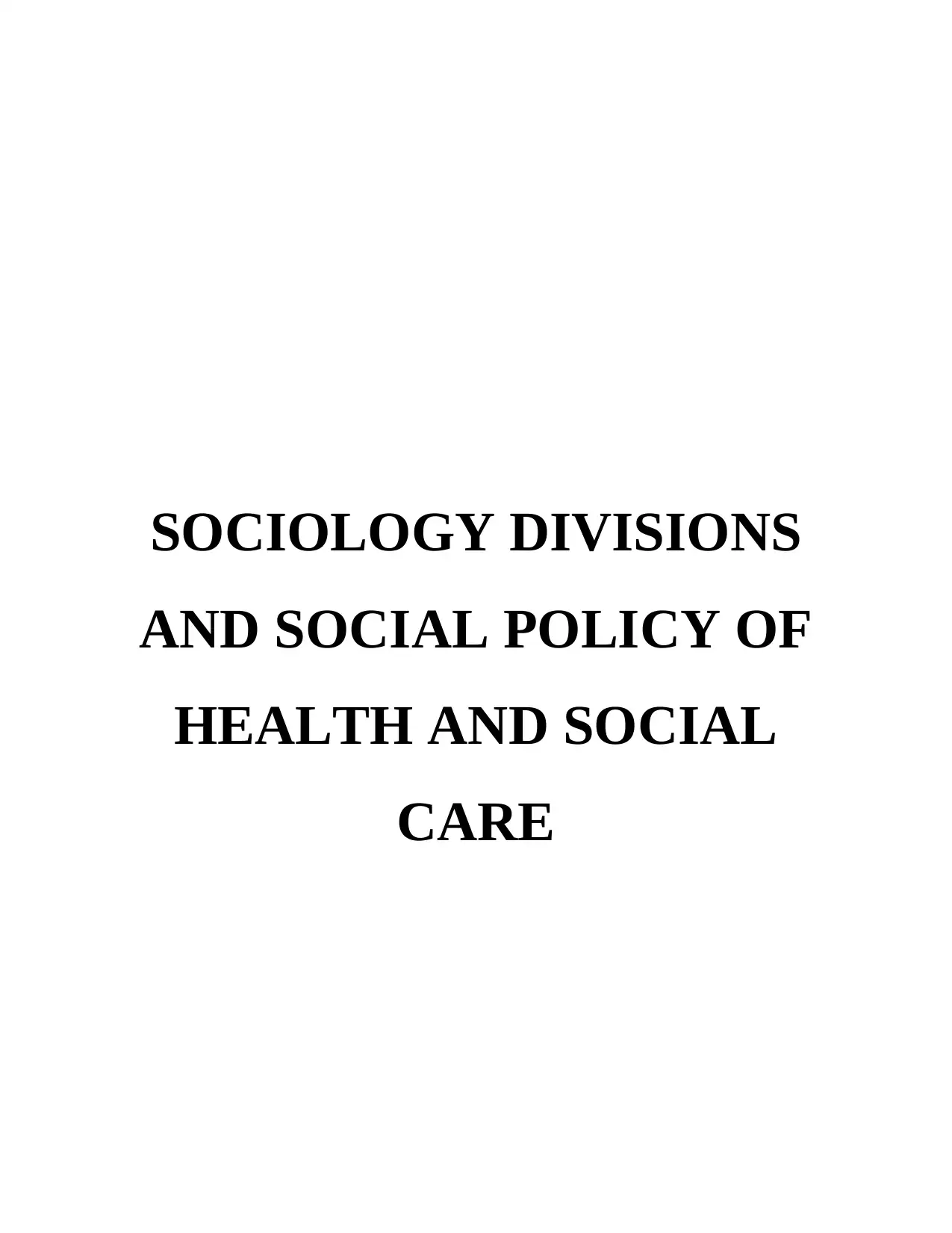
SOCIOLOGY DIVISIONS
AND SOCIAL POLICY OF
HEALTH AND SOCIAL
CARE
AND SOCIAL POLICY OF
HEALTH AND SOCIAL
CARE
Secure Best Marks with AI Grader
Need help grading? Try our AI Grader for instant feedback on your assignments.
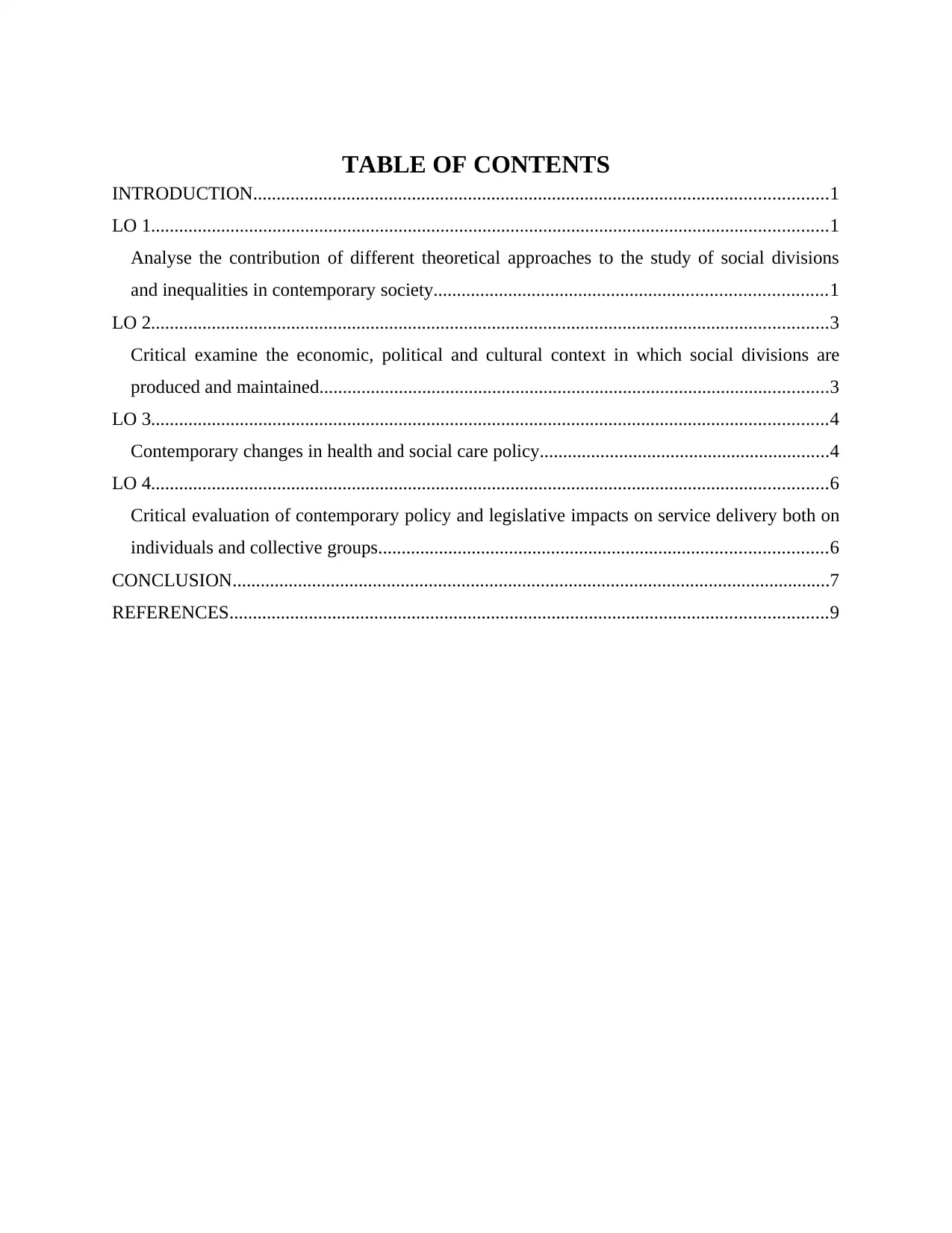
TABLE OF CONTENTS
INTRODUCTION...........................................................................................................................1
LO 1.................................................................................................................................................1
Analyse the contribution of different theoretical approaches to the study of social divisions
and inequalities in contemporary society....................................................................................1
LO 2.................................................................................................................................................3
Critical examine the economic, political and cultural context in which social divisions are
produced and maintained.............................................................................................................3
LO 3.................................................................................................................................................4
Contemporary changes in health and social care policy..............................................................4
LO 4.................................................................................................................................................6
Critical evaluation of contemporary policy and legislative impacts on service delivery both on
individuals and collective groups................................................................................................6
CONCLUSION................................................................................................................................7
REFERENCES................................................................................................................................9
INTRODUCTION...........................................................................................................................1
LO 1.................................................................................................................................................1
Analyse the contribution of different theoretical approaches to the study of social divisions
and inequalities in contemporary society....................................................................................1
LO 2.................................................................................................................................................3
Critical examine the economic, political and cultural context in which social divisions are
produced and maintained.............................................................................................................3
LO 3.................................................................................................................................................4
Contemporary changes in health and social care policy..............................................................4
LO 4.................................................................................................................................................6
Critical evaluation of contemporary policy and legislative impacts on service delivery both on
individuals and collective groups................................................................................................6
CONCLUSION................................................................................................................................7
REFERENCES................................................................................................................................9
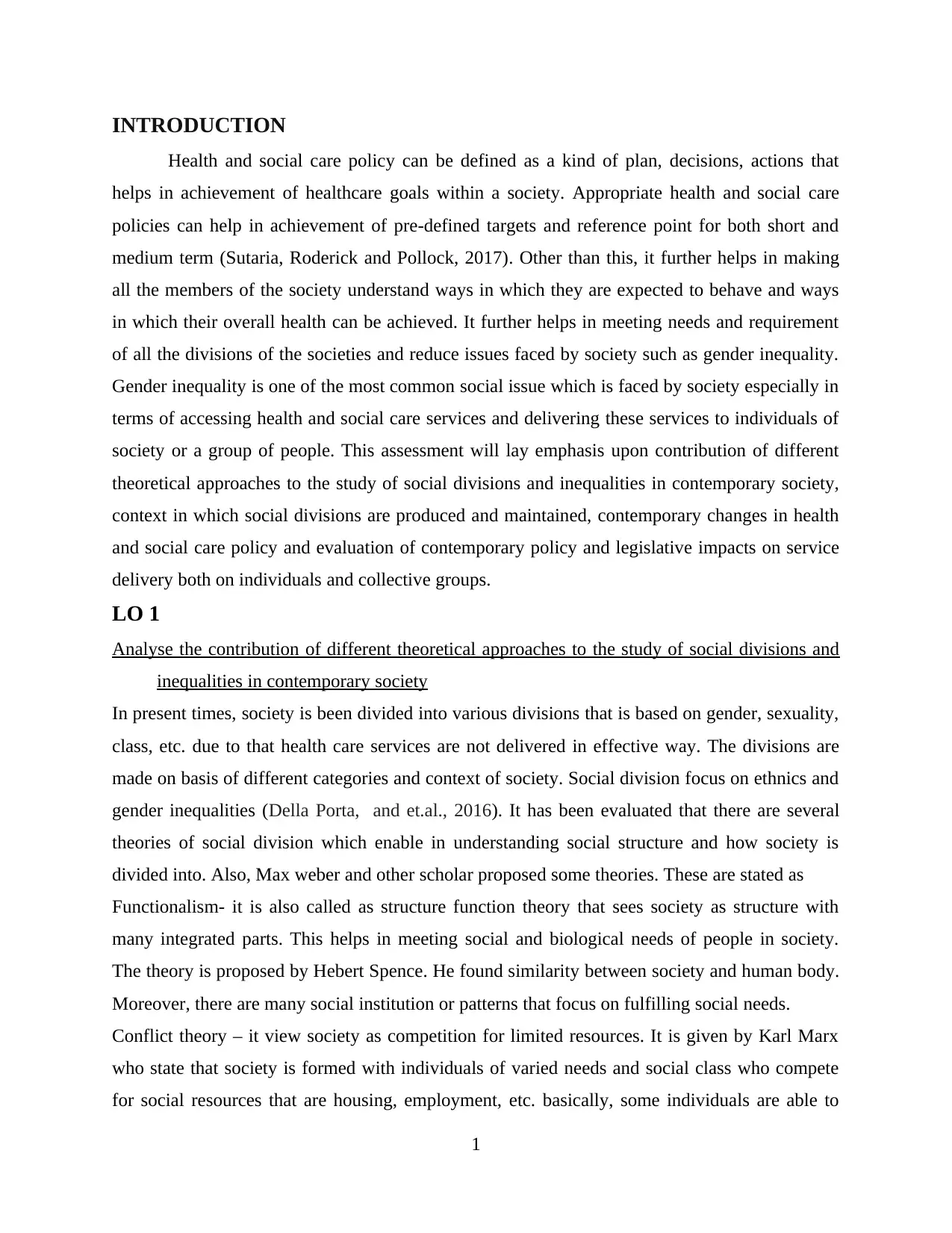
INTRODUCTION
Health and social care policy can be defined as a kind of plan, decisions, actions that
helps in achievement of healthcare goals within a society. Appropriate health and social care
policies can help in achievement of pre-defined targets and reference point for both short and
medium term (Sutaria, Roderick and Pollock, 2017). Other than this, it further helps in making
all the members of the society understand ways in which they are expected to behave and ways
in which their overall health can be achieved. It further helps in meeting needs and requirement
of all the divisions of the societies and reduce issues faced by society such as gender inequality.
Gender inequality is one of the most common social issue which is faced by society especially in
terms of accessing health and social care services and delivering these services to individuals of
society or a group of people. This assessment will lay emphasis upon contribution of different
theoretical approaches to the study of social divisions and inequalities in contemporary society,
context in which social divisions are produced and maintained, contemporary changes in health
and social care policy and evaluation of contemporary policy and legislative impacts on service
delivery both on individuals and collective groups.
LO 1
Analyse the contribution of different theoretical approaches to the study of social divisions and
inequalities in contemporary society
In present times, society is been divided into various divisions that is based on gender, sexuality,
class, etc. due to that health care services are not delivered in effective way. The divisions are
made on basis of different categories and context of society. Social division focus on ethnics and
gender inequalities (Della Porta, and et.al., 2016). It has been evaluated that there are several
theories of social division which enable in understanding social structure and how society is
divided into. Also, Max weber and other scholar proposed some theories. These are stated as
Functionalism- it is also called as structure function theory that sees society as structure with
many integrated parts. This helps in meeting social and biological needs of people in society.
The theory is proposed by Hebert Spence. He found similarity between society and human body.
Moreover, there are many social institution or patterns that focus on fulfilling social needs.
Conflict theory – it view society as competition for limited resources. It is given by Karl Marx
who state that society is formed with individuals of varied needs and social class who compete
for social resources that are housing, employment, etc. basically, some individuals are able to
1
Health and social care policy can be defined as a kind of plan, decisions, actions that
helps in achievement of healthcare goals within a society. Appropriate health and social care
policies can help in achievement of pre-defined targets and reference point for both short and
medium term (Sutaria, Roderick and Pollock, 2017). Other than this, it further helps in making
all the members of the society understand ways in which they are expected to behave and ways
in which their overall health can be achieved. It further helps in meeting needs and requirement
of all the divisions of the societies and reduce issues faced by society such as gender inequality.
Gender inequality is one of the most common social issue which is faced by society especially in
terms of accessing health and social care services and delivering these services to individuals of
society or a group of people. This assessment will lay emphasis upon contribution of different
theoretical approaches to the study of social divisions and inequalities in contemporary society,
context in which social divisions are produced and maintained, contemporary changes in health
and social care policy and evaluation of contemporary policy and legislative impacts on service
delivery both on individuals and collective groups.
LO 1
Analyse the contribution of different theoretical approaches to the study of social divisions and
inequalities in contemporary society
In present times, society is been divided into various divisions that is based on gender, sexuality,
class, etc. due to that health care services are not delivered in effective way. The divisions are
made on basis of different categories and context of society. Social division focus on ethnics and
gender inequalities (Della Porta, and et.al., 2016). It has been evaluated that there are several
theories of social division which enable in understanding social structure and how society is
divided into. Also, Max weber and other scholar proposed some theories. These are stated as
Functionalism- it is also called as structure function theory that sees society as structure with
many integrated parts. This helps in meeting social and biological needs of people in society.
The theory is proposed by Hebert Spence. He found similarity between society and human body.
Moreover, there are many social institution or patterns that focus on fulfilling social needs.
Conflict theory – it view society as competition for limited resources. It is given by Karl Marx
who state that society is formed with individuals of varied needs and social class who compete
for social resources that are housing, employment, etc. basically, some individuals are able to
1
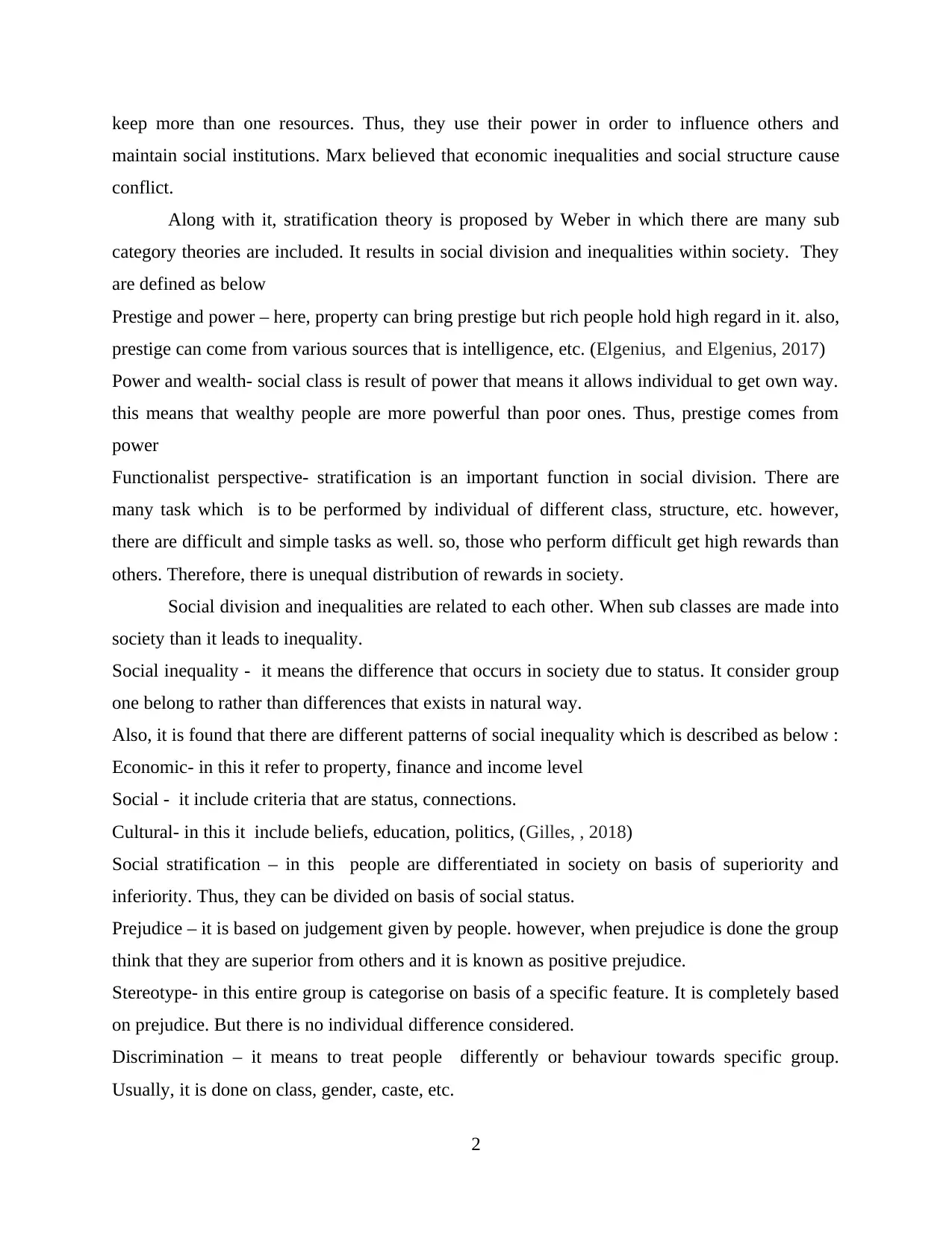
keep more than one resources. Thus, they use their power in order to influence others and
maintain social institutions. Marx believed that economic inequalities and social structure cause
conflict.
Along with it, stratification theory is proposed by Weber in which there are many sub
category theories are included. It results in social division and inequalities within society. They
are defined as below
Prestige and power – here, property can bring prestige but rich people hold high regard in it. also,
prestige can come from various sources that is intelligence, etc. (Elgenius, and Elgenius, 2017)
Power and wealth- social class is result of power that means it allows individual to get own way.
this means that wealthy people are more powerful than poor ones. Thus, prestige comes from
power
Functionalist perspective- stratification is an important function in social division. There are
many task which is to be performed by individual of different class, structure, etc. however,
there are difficult and simple tasks as well. so, those who perform difficult get high rewards than
others. Therefore, there is unequal distribution of rewards in society.
Social division and inequalities are related to each other. When sub classes are made into
society than it leads to inequality.
Social inequality - it means the difference that occurs in society due to status. It consider group
one belong to rather than differences that exists in natural way.
Also, it is found that there are different patterns of social inequality which is described as below :
Economic- in this it refer to property, finance and income level
Social - it include criteria that are status, connections.
Cultural- in this it include beliefs, education, politics, (Gilles, , 2018)
Social stratification – in this people are differentiated in society on basis of superiority and
inferiority. Thus, they can be divided on basis of social status.
Prejudice – it is based on judgement given by people. however, when prejudice is done the group
think that they are superior from others and it is known as positive prejudice.
Stereotype- in this entire group is categorise on basis of a specific feature. It is completely based
on prejudice. But there is no individual difference considered.
Discrimination – it means to treat people differently or behaviour towards specific group.
Usually, it is done on class, gender, caste, etc.
2
maintain social institutions. Marx believed that economic inequalities and social structure cause
conflict.
Along with it, stratification theory is proposed by Weber in which there are many sub
category theories are included. It results in social division and inequalities within society. They
are defined as below
Prestige and power – here, property can bring prestige but rich people hold high regard in it. also,
prestige can come from various sources that is intelligence, etc. (Elgenius, and Elgenius, 2017)
Power and wealth- social class is result of power that means it allows individual to get own way.
this means that wealthy people are more powerful than poor ones. Thus, prestige comes from
power
Functionalist perspective- stratification is an important function in social division. There are
many task which is to be performed by individual of different class, structure, etc. however,
there are difficult and simple tasks as well. so, those who perform difficult get high rewards than
others. Therefore, there is unequal distribution of rewards in society.
Social division and inequalities are related to each other. When sub classes are made into
society than it leads to inequality.
Social inequality - it means the difference that occurs in society due to status. It consider group
one belong to rather than differences that exists in natural way.
Also, it is found that there are different patterns of social inequality which is described as below :
Economic- in this it refer to property, finance and income level
Social - it include criteria that are status, connections.
Cultural- in this it include beliefs, education, politics, (Gilles, , 2018)
Social stratification – in this people are differentiated in society on basis of superiority and
inferiority. Thus, they can be divided on basis of social status.
Prejudice – it is based on judgement given by people. however, when prejudice is done the group
think that they are superior from others and it is known as positive prejudice.
Stereotype- in this entire group is categorise on basis of a specific feature. It is completely based
on prejudice. But there is no individual difference considered.
Discrimination – it means to treat people differently or behaviour towards specific group.
Usually, it is done on class, gender, caste, etc.
2
Secure Best Marks with AI Grader
Need help grading? Try our AI Grader for instant feedback on your assignments.
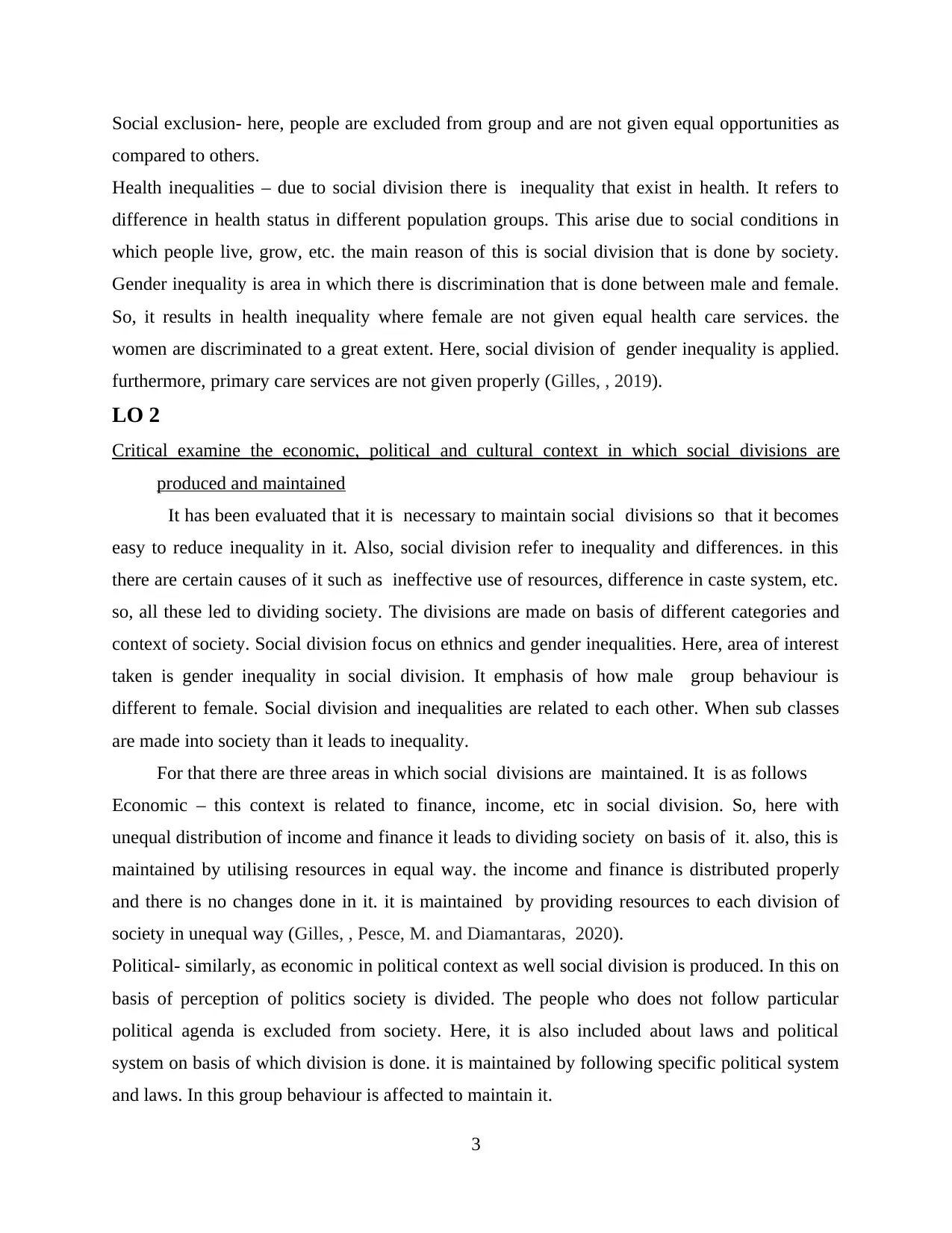
Social exclusion- here, people are excluded from group and are not given equal opportunities as
compared to others.
Health inequalities – due to social division there is inequality that exist in health. It refers to
difference in health status in different population groups. This arise due to social conditions in
which people live, grow, etc. the main reason of this is social division that is done by society.
Gender inequality is area in which there is discrimination that is done between male and female.
So, it results in health inequality where female are not given equal health care services. the
women are discriminated to a great extent. Here, social division of gender inequality is applied.
furthermore, primary care services are not given properly (Gilles, , 2019).
LO 2
Critical examine the economic, political and cultural context in which social divisions are
produced and maintained
It has been evaluated that it is necessary to maintain social divisions so that it becomes
easy to reduce inequality in it. Also, social division refer to inequality and differences. in this
there are certain causes of it such as ineffective use of resources, difference in caste system, etc.
so, all these led to dividing society. The divisions are made on basis of different categories and
context of society. Social division focus on ethnics and gender inequalities. Here, area of interest
taken is gender inequality in social division. It emphasis of how male group behaviour is
different to female. Social division and inequalities are related to each other. When sub classes
are made into society than it leads to inequality.
For that there are three areas in which social divisions are maintained. It is as follows
Economic – this context is related to finance, income, etc in social division. So, here with
unequal distribution of income and finance it leads to dividing society on basis of it. also, this is
maintained by utilising resources in equal way. the income and finance is distributed properly
and there is no changes done in it. it is maintained by providing resources to each division of
society in unequal way (Gilles, , Pesce, M. and Diamantaras, 2020).
Political- similarly, as economic in political context as well social division is produced. In this on
basis of perception of politics society is divided. The people who does not follow particular
political agenda is excluded from society. Here, it is also included about laws and political
system on basis of which division is done. it is maintained by following specific political system
and laws. In this group behaviour is affected to maintain it.
3
compared to others.
Health inequalities – due to social division there is inequality that exist in health. It refers to
difference in health status in different population groups. This arise due to social conditions in
which people live, grow, etc. the main reason of this is social division that is done by society.
Gender inequality is area in which there is discrimination that is done between male and female.
So, it results in health inequality where female are not given equal health care services. the
women are discriminated to a great extent. Here, social division of gender inequality is applied.
furthermore, primary care services are not given properly (Gilles, , 2019).
LO 2
Critical examine the economic, political and cultural context in which social divisions are
produced and maintained
It has been evaluated that it is necessary to maintain social divisions so that it becomes
easy to reduce inequality in it. Also, social division refer to inequality and differences. in this
there are certain causes of it such as ineffective use of resources, difference in caste system, etc.
so, all these led to dividing society. The divisions are made on basis of different categories and
context of society. Social division focus on ethnics and gender inequalities. Here, area of interest
taken is gender inequality in social division. It emphasis of how male group behaviour is
different to female. Social division and inequalities are related to each other. When sub classes
are made into society than it leads to inequality.
For that there are three areas in which social divisions are maintained. It is as follows
Economic – this context is related to finance, income, etc in social division. So, here with
unequal distribution of income and finance it leads to dividing society on basis of it. also, this is
maintained by utilising resources in equal way. the income and finance is distributed properly
and there is no changes done in it. it is maintained by providing resources to each division of
society in unequal way (Gilles, , Pesce, M. and Diamantaras, 2020).
Political- similarly, as economic in political context as well social division is produced. In this on
basis of perception of politics society is divided. The people who does not follow particular
political agenda is excluded from society. Here, it is also included about laws and political
system on basis of which division is done. it is maintained by following specific political system
and laws. In this group behaviour is affected to maintain it.
3
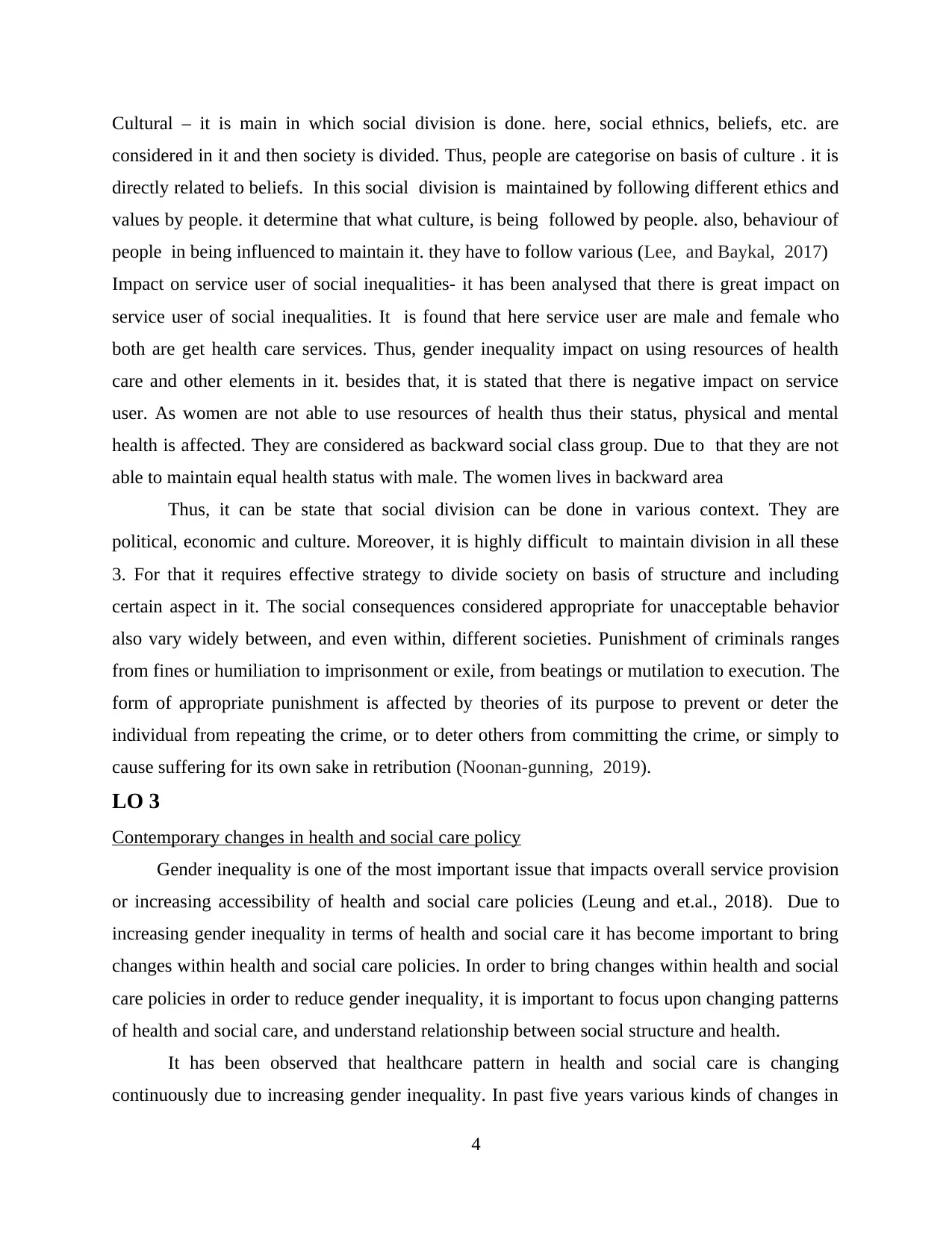
Cultural – it is main in which social division is done. here, social ethnics, beliefs, etc. are
considered in it and then society is divided. Thus, people are categorise on basis of culture . it is
directly related to beliefs. In this social division is maintained by following different ethics and
values by people. it determine that what culture, is being followed by people. also, behaviour of
people in being influenced to maintain it. they have to follow various (Lee, and Baykal, 2017)
Impact on service user of social inequalities- it has been analysed that there is great impact on
service user of social inequalities. It is found that here service user are male and female who
both are get health care services. Thus, gender inequality impact on using resources of health
care and other elements in it. besides that, it is stated that there is negative impact on service
user. As women are not able to use resources of health thus their status, physical and mental
health is affected. They are considered as backward social class group. Due to that they are not
able to maintain equal health status with male. The women lives in backward area
Thus, it can be state that social division can be done in various context. They are
political, economic and culture. Moreover, it is highly difficult to maintain division in all these
3. For that it requires effective strategy to divide society on basis of structure and including
certain aspect in it. The social consequences considered appropriate for unacceptable behavior
also vary widely between, and even within, different societies. Punishment of criminals ranges
from fines or humiliation to imprisonment or exile, from beatings or mutilation to execution. The
form of appropriate punishment is affected by theories of its purpose to prevent or deter the
individual from repeating the crime, or to deter others from committing the crime, or simply to
cause suffering for its own sake in retribution (Noonan-gunning, 2019).
LO 3
Contemporary changes in health and social care policy
Gender inequality is one of the most important issue that impacts overall service provision
or increasing accessibility of health and social care policies (Leung and et.al., 2018). Due to
increasing gender inequality in terms of health and social care it has become important to bring
changes within health and social care policies. In order to bring changes within health and social
care policies in order to reduce gender inequality, it is important to focus upon changing patterns
of health and social care, and understand relationship between social structure and health.
It has been observed that healthcare pattern in health and social care is changing
continuously due to increasing gender inequality. In past five years various kinds of changes in
4
considered in it and then society is divided. Thus, people are categorise on basis of culture . it is
directly related to beliefs. In this social division is maintained by following different ethics and
values by people. it determine that what culture, is being followed by people. also, behaviour of
people in being influenced to maintain it. they have to follow various (Lee, and Baykal, 2017)
Impact on service user of social inequalities- it has been analysed that there is great impact on
service user of social inequalities. It is found that here service user are male and female who
both are get health care services. Thus, gender inequality impact on using resources of health
care and other elements in it. besides that, it is stated that there is negative impact on service
user. As women are not able to use resources of health thus their status, physical and mental
health is affected. They are considered as backward social class group. Due to that they are not
able to maintain equal health status with male. The women lives in backward area
Thus, it can be state that social division can be done in various context. They are
political, economic and culture. Moreover, it is highly difficult to maintain division in all these
3. For that it requires effective strategy to divide society on basis of structure and including
certain aspect in it. The social consequences considered appropriate for unacceptable behavior
also vary widely between, and even within, different societies. Punishment of criminals ranges
from fines or humiliation to imprisonment or exile, from beatings or mutilation to execution. The
form of appropriate punishment is affected by theories of its purpose to prevent or deter the
individual from repeating the crime, or to deter others from committing the crime, or simply to
cause suffering for its own sake in retribution (Noonan-gunning, 2019).
LO 3
Contemporary changes in health and social care policy
Gender inequality is one of the most important issue that impacts overall service provision
or increasing accessibility of health and social care policies (Leung and et.al., 2018). Due to
increasing gender inequality in terms of health and social care it has become important to bring
changes within health and social care policies. In order to bring changes within health and social
care policies in order to reduce gender inequality, it is important to focus upon changing patterns
of health and social care, and understand relationship between social structure and health.
It has been observed that healthcare pattern in health and social care is changing
continuously due to increasing gender inequality. In past five years various kinds of changes in
4
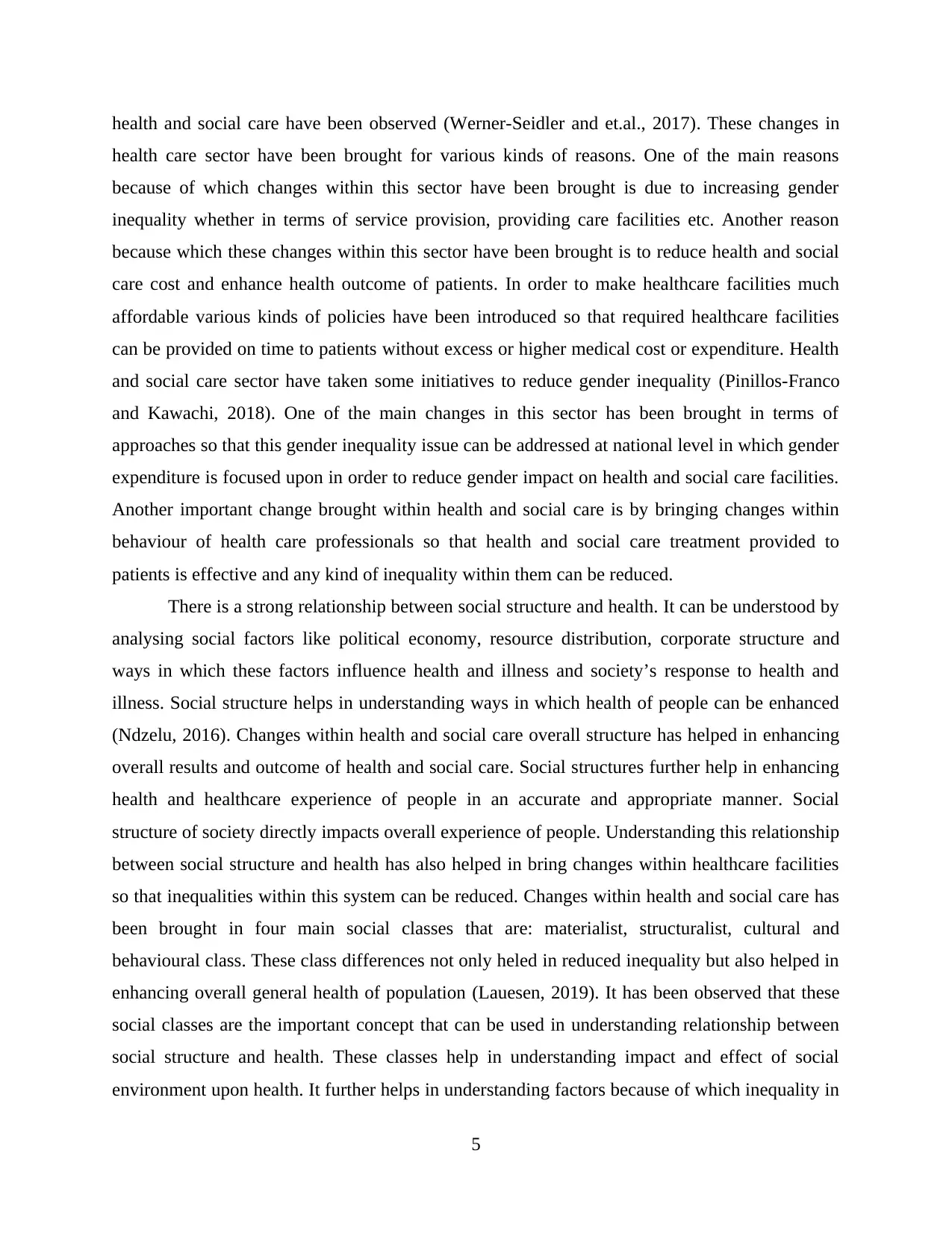
health and social care have been observed (Werner-Seidler and et.al., 2017). These changes in
health care sector have been brought for various kinds of reasons. One of the main reasons
because of which changes within this sector have been brought is due to increasing gender
inequality whether in terms of service provision, providing care facilities etc. Another reason
because which these changes within this sector have been brought is to reduce health and social
care cost and enhance health outcome of patients. In order to make healthcare facilities much
affordable various kinds of policies have been introduced so that required healthcare facilities
can be provided on time to patients without excess or higher medical cost or expenditure. Health
and social care sector have taken some initiatives to reduce gender inequality (Pinillos-Franco
and Kawachi, 2018). One of the main changes in this sector has been brought in terms of
approaches so that this gender inequality issue can be addressed at national level in which gender
expenditure is focused upon in order to reduce gender impact on health and social care facilities.
Another important change brought within health and social care is by bringing changes within
behaviour of health care professionals so that health and social care treatment provided to
patients is effective and any kind of inequality within them can be reduced.
There is a strong relationship between social structure and health. It can be understood by
analysing social factors like political economy, resource distribution, corporate structure and
ways in which these factors influence health and illness and society’s response to health and
illness. Social structure helps in understanding ways in which health of people can be enhanced
(Ndzelu, 2016). Changes within health and social care overall structure has helped in enhancing
overall results and outcome of health and social care. Social structures further help in enhancing
health and healthcare experience of people in an accurate and appropriate manner. Social
structure of society directly impacts overall experience of people. Understanding this relationship
between social structure and health has also helped in bring changes within healthcare facilities
so that inequalities within this system can be reduced. Changes within health and social care has
been brought in four main social classes that are: materialist, structuralist, cultural and
behavioural class. These class differences not only heled in reduced inequality but also helped in
enhancing overall general health of population (Lauesen, 2019). It has been observed that these
social classes are the important concept that can be used in understanding relationship between
social structure and health. These classes help in understanding impact and effect of social
environment upon health. It further helps in understanding factors because of which inequality in
5
health care sector have been brought for various kinds of reasons. One of the main reasons
because of which changes within this sector have been brought is due to increasing gender
inequality whether in terms of service provision, providing care facilities etc. Another reason
because which these changes within this sector have been brought is to reduce health and social
care cost and enhance health outcome of patients. In order to make healthcare facilities much
affordable various kinds of policies have been introduced so that required healthcare facilities
can be provided on time to patients without excess or higher medical cost or expenditure. Health
and social care sector have taken some initiatives to reduce gender inequality (Pinillos-Franco
and Kawachi, 2018). One of the main changes in this sector has been brought in terms of
approaches so that this gender inequality issue can be addressed at national level in which gender
expenditure is focused upon in order to reduce gender impact on health and social care facilities.
Another important change brought within health and social care is by bringing changes within
behaviour of health care professionals so that health and social care treatment provided to
patients is effective and any kind of inequality within them can be reduced.
There is a strong relationship between social structure and health. It can be understood by
analysing social factors like political economy, resource distribution, corporate structure and
ways in which these factors influence health and illness and society’s response to health and
illness. Social structure helps in understanding ways in which health of people can be enhanced
(Ndzelu, 2016). Changes within health and social care overall structure has helped in enhancing
overall results and outcome of health and social care. Social structures further help in enhancing
health and healthcare experience of people in an accurate and appropriate manner. Social
structure of society directly impacts overall experience of people. Understanding this relationship
between social structure and health has also helped in bring changes within healthcare facilities
so that inequalities within this system can be reduced. Changes within health and social care has
been brought in four main social classes that are: materialist, structuralist, cultural and
behavioural class. These class differences not only heled in reduced inequality but also helped in
enhancing overall general health of population (Lauesen, 2019). It has been observed that these
social classes are the important concept that can be used in understanding relationship between
social structure and health. These classes help in understanding impact and effect of social
environment upon health. It further helps in understanding factors because of which inequality in
5
Paraphrase This Document
Need a fresh take? Get an instant paraphrase of this document with our AI Paraphraser
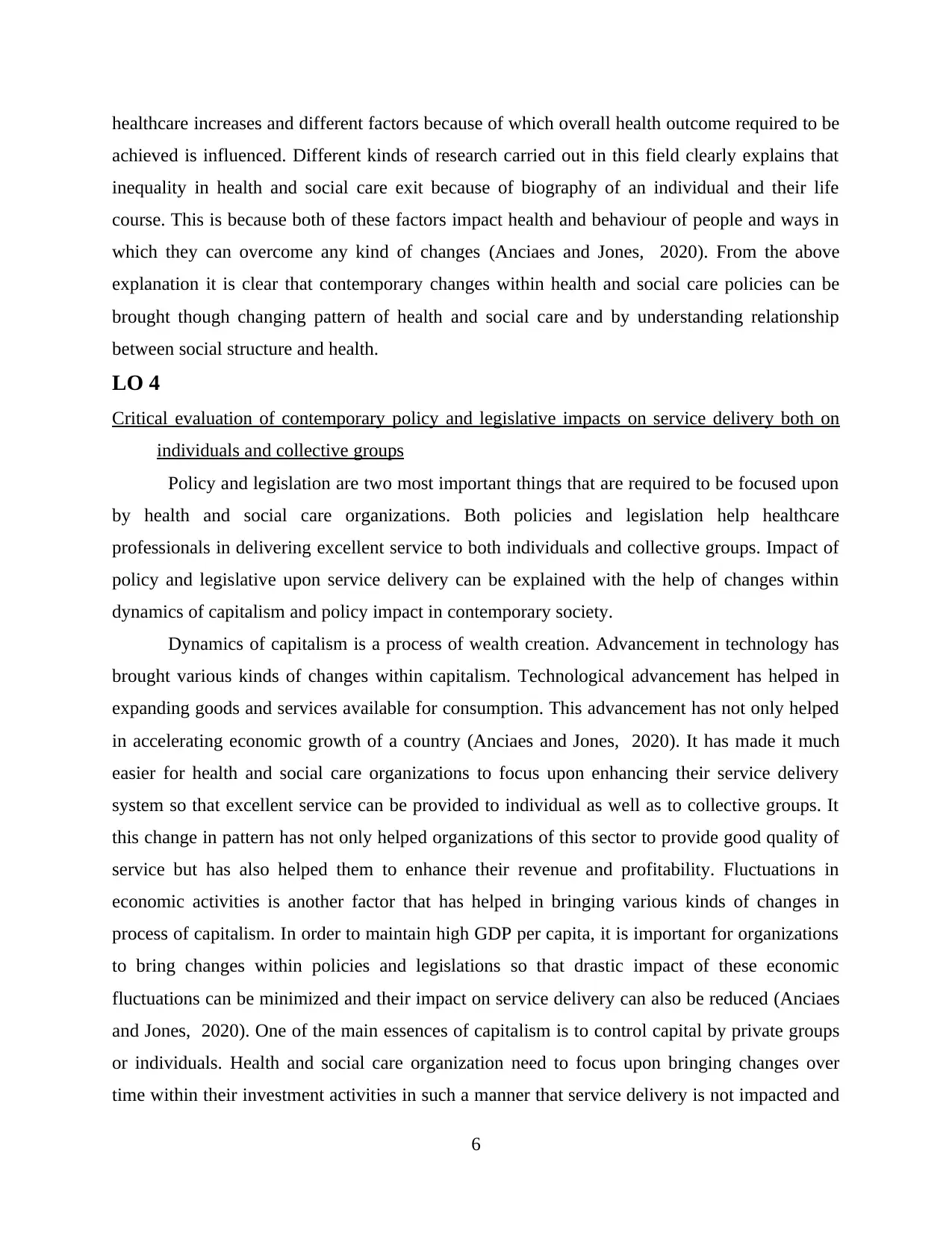
healthcare increases and different factors because of which overall health outcome required to be
achieved is influenced. Different kinds of research carried out in this field clearly explains that
inequality in health and social care exit because of biography of an individual and their life
course. This is because both of these factors impact health and behaviour of people and ways in
which they can overcome any kind of changes (Anciaes and Jones, 2020). From the above
explanation it is clear that contemporary changes within health and social care policies can be
brought though changing pattern of health and social care and by understanding relationship
between social structure and health.
LO 4
Critical evaluation of contemporary policy and legislative impacts on service delivery both on
individuals and collective groups
Policy and legislation are two most important things that are required to be focused upon
by health and social care organizations. Both policies and legislation help healthcare
professionals in delivering excellent service to both individuals and collective groups. Impact of
policy and legislative upon service delivery can be explained with the help of changes within
dynamics of capitalism and policy impact in contemporary society.
Dynamics of capitalism is a process of wealth creation. Advancement in technology has
brought various kinds of changes within capitalism. Technological advancement has helped in
expanding goods and services available for consumption. This advancement has not only helped
in accelerating economic growth of a country (Anciaes and Jones, 2020). It has made it much
easier for health and social care organizations to focus upon enhancing their service delivery
system so that excellent service can be provided to individual as well as to collective groups. It
this change in pattern has not only helped organizations of this sector to provide good quality of
service but has also helped them to enhance their revenue and profitability. Fluctuations in
economic activities is another factor that has helped in bringing various kinds of changes in
process of capitalism. In order to maintain high GDP per capita, it is important for organizations
to bring changes within policies and legislations so that drastic impact of these economic
fluctuations can be minimized and their impact on service delivery can also be reduced (Anciaes
and Jones, 2020). One of the main essences of capitalism is to control capital by private groups
or individuals. Health and social care organization need to focus upon bringing changes over
time within their investment activities in such a manner that service delivery is not impacted and
6
achieved is influenced. Different kinds of research carried out in this field clearly explains that
inequality in health and social care exit because of biography of an individual and their life
course. This is because both of these factors impact health and behaviour of people and ways in
which they can overcome any kind of changes (Anciaes and Jones, 2020). From the above
explanation it is clear that contemporary changes within health and social care policies can be
brought though changing pattern of health and social care and by understanding relationship
between social structure and health.
LO 4
Critical evaluation of contemporary policy and legislative impacts on service delivery both on
individuals and collective groups
Policy and legislation are two most important things that are required to be focused upon
by health and social care organizations. Both policies and legislation help healthcare
professionals in delivering excellent service to both individuals and collective groups. Impact of
policy and legislative upon service delivery can be explained with the help of changes within
dynamics of capitalism and policy impact in contemporary society.
Dynamics of capitalism is a process of wealth creation. Advancement in technology has
brought various kinds of changes within capitalism. Technological advancement has helped in
expanding goods and services available for consumption. This advancement has not only helped
in accelerating economic growth of a country (Anciaes and Jones, 2020). It has made it much
easier for health and social care organizations to focus upon enhancing their service delivery
system so that excellent service can be provided to individual as well as to collective groups. It
this change in pattern has not only helped organizations of this sector to provide good quality of
service but has also helped them to enhance their revenue and profitability. Fluctuations in
economic activities is another factor that has helped in bringing various kinds of changes in
process of capitalism. In order to maintain high GDP per capita, it is important for organizations
to bring changes within policies and legislations so that drastic impact of these economic
fluctuations can be minimized and their impact on service delivery can also be reduced (Anciaes
and Jones, 2020). One of the main essences of capitalism is to control capital by private groups
or individuals. Health and social care organization need to focus upon bringing changes over
time within their investment activities in such a manner that service delivery is not impacted and
6
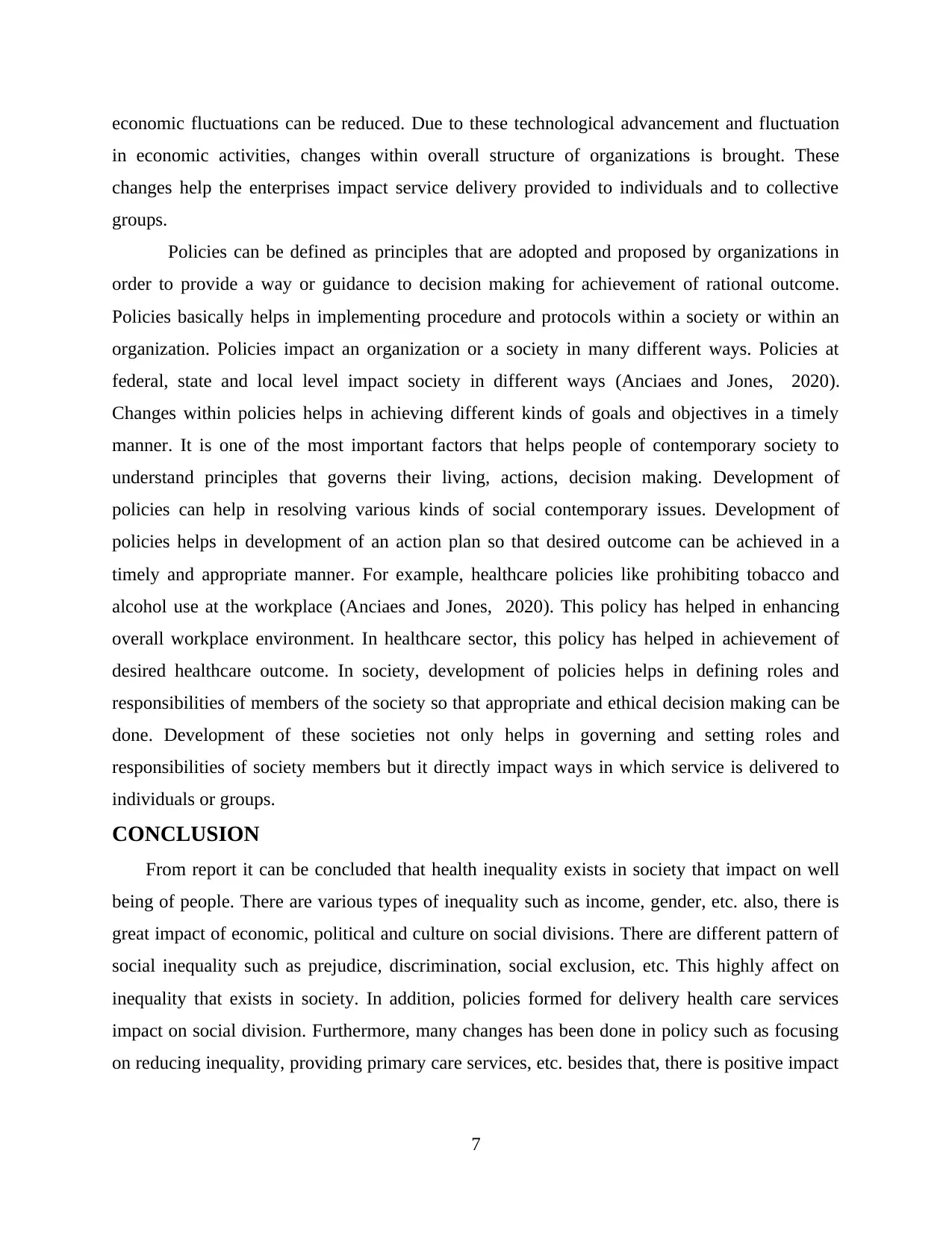
economic fluctuations can be reduced. Due to these technological advancement and fluctuation
in economic activities, changes within overall structure of organizations is brought. These
changes help the enterprises impact service delivery provided to individuals and to collective
groups.
Policies can be defined as principles that are adopted and proposed by organizations in
order to provide a way or guidance to decision making for achievement of rational outcome.
Policies basically helps in implementing procedure and protocols within a society or within an
organization. Policies impact an organization or a society in many different ways. Policies at
federal, state and local level impact society in different ways (Anciaes and Jones, 2020).
Changes within policies helps in achieving different kinds of goals and objectives in a timely
manner. It is one of the most important factors that helps people of contemporary society to
understand principles that governs their living, actions, decision making. Development of
policies can help in resolving various kinds of social contemporary issues. Development of
policies helps in development of an action plan so that desired outcome can be achieved in a
timely and appropriate manner. For example, healthcare policies like prohibiting tobacco and
alcohol use at the workplace (Anciaes and Jones, 2020). This policy has helped in enhancing
overall workplace environment. In healthcare sector, this policy has helped in achievement of
desired healthcare outcome. In society, development of policies helps in defining roles and
responsibilities of members of the society so that appropriate and ethical decision making can be
done. Development of these societies not only helps in governing and setting roles and
responsibilities of society members but it directly impact ways in which service is delivered to
individuals or groups.
CONCLUSION
From report it can be concluded that health inequality exists in society that impact on well
being of people. There are various types of inequality such as income, gender, etc. also, there is
great impact of economic, political and culture on social divisions. There are different pattern of
social inequality such as prejudice, discrimination, social exclusion, etc. This highly affect on
inequality that exists in society. In addition, policies formed for delivery health care services
impact on social division. Furthermore, many changes has been done in policy such as focusing
on reducing inequality, providing primary care services, etc. besides that, there is positive impact
7
in economic activities, changes within overall structure of organizations is brought. These
changes help the enterprises impact service delivery provided to individuals and to collective
groups.
Policies can be defined as principles that are adopted and proposed by organizations in
order to provide a way or guidance to decision making for achievement of rational outcome.
Policies basically helps in implementing procedure and protocols within a society or within an
organization. Policies impact an organization or a society in many different ways. Policies at
federal, state and local level impact society in different ways (Anciaes and Jones, 2020).
Changes within policies helps in achieving different kinds of goals and objectives in a timely
manner. It is one of the most important factors that helps people of contemporary society to
understand principles that governs their living, actions, decision making. Development of
policies can help in resolving various kinds of social contemporary issues. Development of
policies helps in development of an action plan so that desired outcome can be achieved in a
timely and appropriate manner. For example, healthcare policies like prohibiting tobacco and
alcohol use at the workplace (Anciaes and Jones, 2020). This policy has helped in enhancing
overall workplace environment. In healthcare sector, this policy has helped in achievement of
desired healthcare outcome. In society, development of policies helps in defining roles and
responsibilities of members of the society so that appropriate and ethical decision making can be
done. Development of these societies not only helps in governing and setting roles and
responsibilities of society members but it directly impact ways in which service is delivered to
individuals or groups.
CONCLUSION
From report it can be concluded that health inequality exists in society that impact on well
being of people. There are various types of inequality such as income, gender, etc. also, there is
great impact of economic, political and culture on social divisions. There are different pattern of
social inequality such as prejudice, discrimination, social exclusion, etc. This highly affect on
inequality that exists in society. In addition, policies formed for delivery health care services
impact on social division. Furthermore, many changes has been done in policy such as focusing
on reducing inequality, providing primary care services, etc. besides that, there is positive impact
7
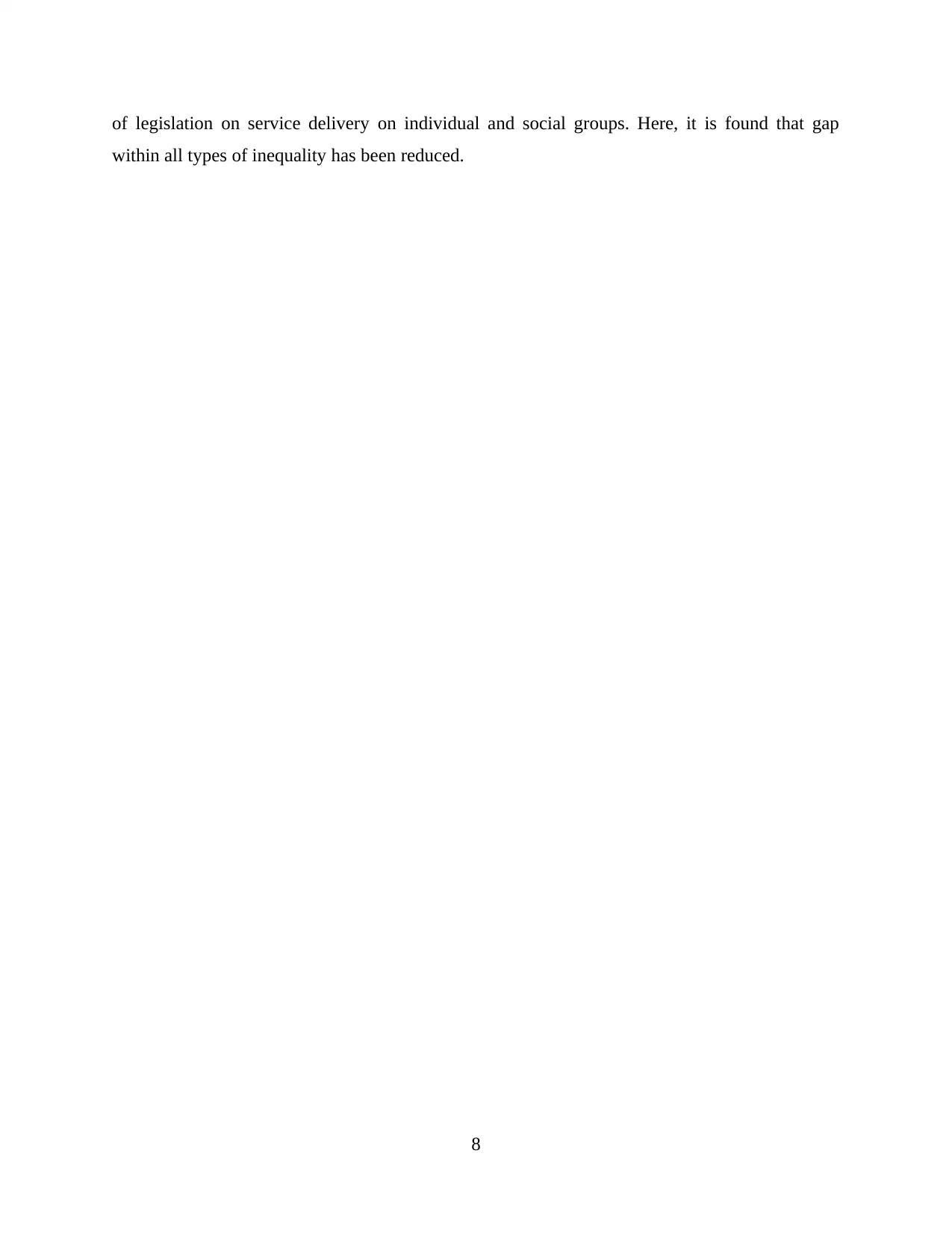
of legislation on service delivery on individual and social groups. Here, it is found that gap
within all types of inequality has been reduced.
8
within all types of inequality has been reduced.
8
Secure Best Marks with AI Grader
Need help grading? Try our AI Grader for instant feedback on your assignments.
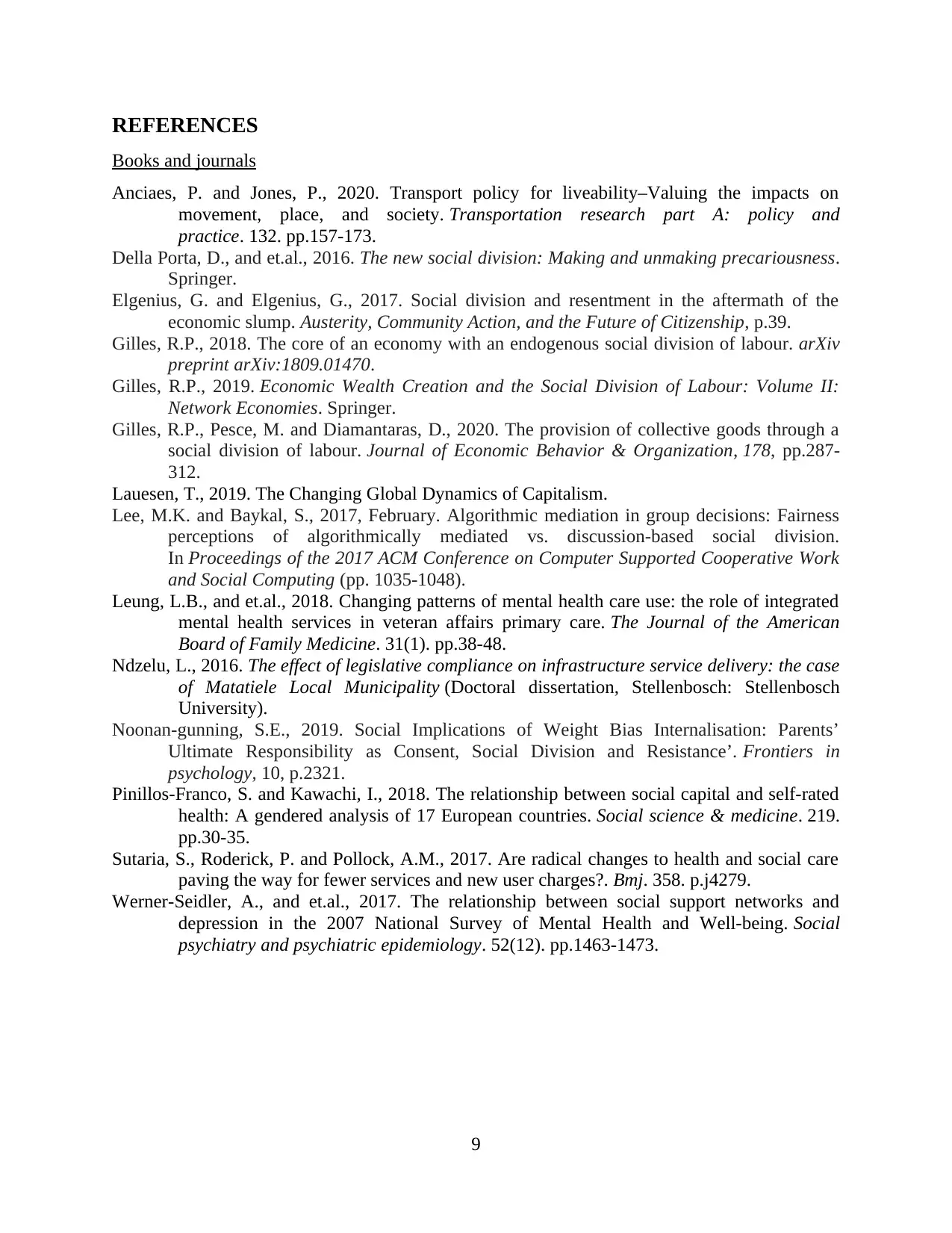
REFERENCES
Books and journals
Anciaes, P. and Jones, P., 2020. Transport policy for liveability–Valuing the impacts on
movement, place, and society. Transportation research part A: policy and
practice. 132. pp.157-173.
Della Porta, D., and et.al., 2016. The new social division: Making and unmaking precariousness.
Springer.
Elgenius, G. and Elgenius, G., 2017. Social division and resentment in the aftermath of the
economic slump. Austerity, Community Action, and the Future of Citizenship, p.39.
Gilles, R.P., 2018. The core of an economy with an endogenous social division of labour. arXiv
preprint arXiv:1809.01470.
Gilles, R.P., 2019. Economic Wealth Creation and the Social Division of Labour: Volume II:
Network Economies. Springer.
Gilles, R.P., Pesce, M. and Diamantaras, D., 2020. The provision of collective goods through a
social division of labour. Journal of Economic Behavior & Organization, 178, pp.287-
312.
Lauesen, T., 2019. The Changing Global Dynamics of Capitalism.
Lee, M.K. and Baykal, S., 2017, February. Algorithmic mediation in group decisions: Fairness
perceptions of algorithmically mediated vs. discussion-based social division.
In Proceedings of the 2017 ACM Conference on Computer Supported Cooperative Work
and Social Computing (pp. 1035-1048).
Leung, L.B., and et.al., 2018. Changing patterns of mental health care use: the role of integrated
mental health services in veteran affairs primary care. The Journal of the American
Board of Family Medicine. 31(1). pp.38-48.
Ndzelu, L., 2016. The effect of legislative compliance on infrastructure service delivery: the case
of Matatiele Local Municipality (Doctoral dissertation, Stellenbosch: Stellenbosch
University).
Noonan-gunning, S.E., 2019. Social Implications of Weight Bias Internalisation: Parents’
Ultimate Responsibility as Consent, Social Division and Resistance’. Frontiers in
psychology, 10, p.2321.
Pinillos-Franco, S. and Kawachi, I., 2018. The relationship between social capital and self-rated
health: A gendered analysis of 17 European countries. Social science & medicine. 219.
pp.30-35.
Sutaria, S., Roderick, P. and Pollock, A.M., 2017. Are radical changes to health and social care
paving the way for fewer services and new user charges?. Bmj. 358. p.j4279.
Werner-Seidler, A., and et.al., 2017. The relationship between social support networks and
depression in the 2007 National Survey of Mental Health and Well-being. Social
psychiatry and psychiatric epidemiology. 52(12). pp.1463-1473.
9
Books and journals
Anciaes, P. and Jones, P., 2020. Transport policy for liveability–Valuing the impacts on
movement, place, and society. Transportation research part A: policy and
practice. 132. pp.157-173.
Della Porta, D., and et.al., 2016. The new social division: Making and unmaking precariousness.
Springer.
Elgenius, G. and Elgenius, G., 2017. Social division and resentment in the aftermath of the
economic slump. Austerity, Community Action, and the Future of Citizenship, p.39.
Gilles, R.P., 2018. The core of an economy with an endogenous social division of labour. arXiv
preprint arXiv:1809.01470.
Gilles, R.P., 2019. Economic Wealth Creation and the Social Division of Labour: Volume II:
Network Economies. Springer.
Gilles, R.P., Pesce, M. and Diamantaras, D., 2020. The provision of collective goods through a
social division of labour. Journal of Economic Behavior & Organization, 178, pp.287-
312.
Lauesen, T., 2019. The Changing Global Dynamics of Capitalism.
Lee, M.K. and Baykal, S., 2017, February. Algorithmic mediation in group decisions: Fairness
perceptions of algorithmically mediated vs. discussion-based social division.
In Proceedings of the 2017 ACM Conference on Computer Supported Cooperative Work
and Social Computing (pp. 1035-1048).
Leung, L.B., and et.al., 2018. Changing patterns of mental health care use: the role of integrated
mental health services in veteran affairs primary care. The Journal of the American
Board of Family Medicine. 31(1). pp.38-48.
Ndzelu, L., 2016. The effect of legislative compliance on infrastructure service delivery: the case
of Matatiele Local Municipality (Doctoral dissertation, Stellenbosch: Stellenbosch
University).
Noonan-gunning, S.E., 2019. Social Implications of Weight Bias Internalisation: Parents’
Ultimate Responsibility as Consent, Social Division and Resistance’. Frontiers in
psychology, 10, p.2321.
Pinillos-Franco, S. and Kawachi, I., 2018. The relationship between social capital and self-rated
health: A gendered analysis of 17 European countries. Social science & medicine. 219.
pp.30-35.
Sutaria, S., Roderick, P. and Pollock, A.M., 2017. Are radical changes to health and social care
paving the way for fewer services and new user charges?. Bmj. 358. p.j4279.
Werner-Seidler, A., and et.al., 2017. The relationship between social support networks and
depression in the 2007 National Survey of Mental Health and Well-being. Social
psychiatry and psychiatric epidemiology. 52(12). pp.1463-1473.
9
1 out of 11
Related Documents
Your All-in-One AI-Powered Toolkit for Academic Success.
+13062052269
info@desklib.com
Available 24*7 on WhatsApp / Email
![[object Object]](/_next/static/media/star-bottom.7253800d.svg)
Unlock your academic potential
© 2024 | Zucol Services PVT LTD | All rights reserved.





